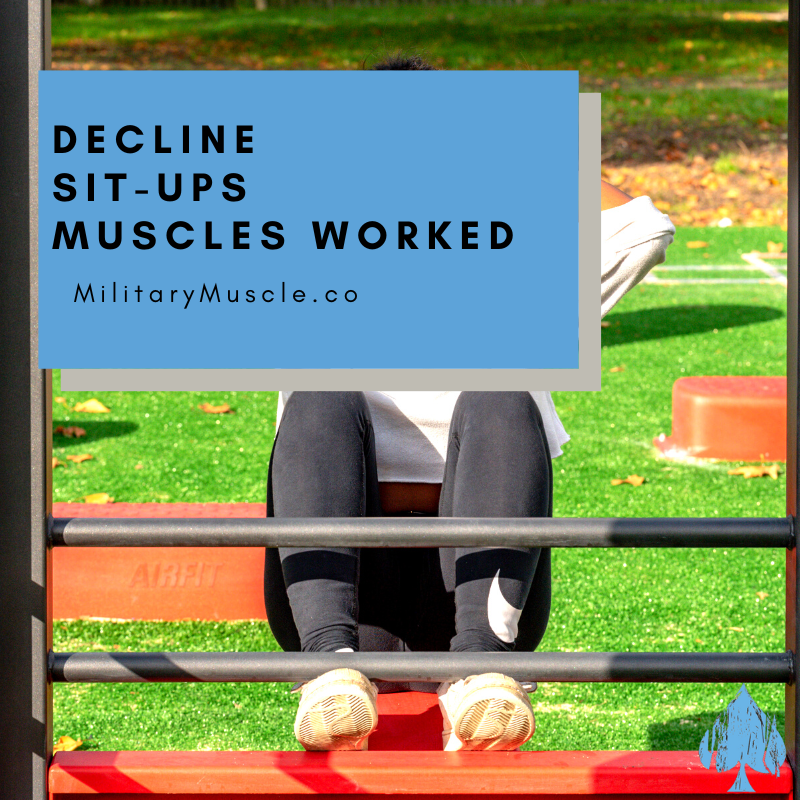Decline Sit Ups Muscles Worked

Written by Ben Bunting: BA, PGCert. (Sport & Exercise Nutrition) // British Army Physical Training Instructor // S&C Coach.
--
The decline sit up is one of the best exercises for the abdominals. This exercise involves the use of both the upper and lower ab muscles, aiding in spinal stabilization. Its benefits include strengthening and toning your entire core. This exercise can be done two to three times per week and is a good choice for beginners. As you get stronger, you can start adding more resistance or repetitions.
Why Is Resistance Training Good For Health?
Resistance training is an excellent way to improve your physical and mental health. It can help you maintain a healthy weight, and it can increase your strength and flexibility. It is also an effective form of stress relief.
Exercise helps release endorphins, a natural chemical that gives you a feeling of well-being. Resistance training also lowers blood pressure and cholesterol levels. You can also build muscle mass and lose excess fat. Increasing your muscles can prevent age-related decline in your muscle strength, which can lead to muscle loss, metabolic syndrome, osteoporosis, and other medical conditions.
Resistance training can be a beneficial addition to any exercise regimen. Studies show that it is one of the most effective forms of weight loss. It is also known to decrease inflammation in overweight women.
In older adults, resistance training can help counter the negative effects of age-related muscle loss. Studies show that people who engage in resistance training experienced a significant improvement in physical function. In fact, nursing home residents who performed six resistance machine exercises twice a week for 14 weeks increased overall strength by 60%. They also improved their functional independence by 14%.
The Importance of Core Exercises
Core exercises are an effective way to improve balance and coordination. These exercises also help relieve aches and pains. Plus, they may even help prevent injuries.
A strong core is the foundation for good posture and other physical movements. This is why core exercises are important, whether you're young or old.
The key is to do them correctly. This is where a certified physical trainer can support and guide you.
Decline sit ups target the core
Decline sit-ups are an excellent way to strengthen the muscles in your midsection. They increase spinal flexion and work core muscles like the rectus abdominis, obliques, and rectus femoris. They also strengthen the chest and back muscles. It also works the iliopsoas, which runs from your hip down to your femur. This type of exercise will also strengthen your hip flexors, which help bring your abdomen toward your thighs.
Decline sit-ups may seem similar to traditional sit-ups, but they're actually quite different. The difference is in the angle of the bench, which increases the range of motion and force you feel. Additionally, the downward angle of the bench increases the moment arm, which increases shear forces in the lumbar spine.
The decline sit-up is a great core-building exercise that requires an incline or decline bench. It can be challenging for beginners and advanced trainers alike, but it is well worth a place in your ab training routine. This exercise is more difficult than basic sit-ups and crunches, so it's best suited for those with a little more training experience.
If you're new to decline sit-ups, try a lower angle at first. Then, work your way up to a higher angle, such as 45 degrees. The key is to maintain control of the negative part of the exercise. You can also add a weight plate, dumbbell, or medicine ball to make the exercise more challenging. During the exercise, place your hands anywhere you want, but avoid placing them on your head.
The decline sit up is best done with a neutral pelvic position. This means that there should be no space between your lower back and the bench. You should use your abdominals and hip flexors to lift your torso off the bench. You should also keep your arms on the sides of your head so that you don't pull your head too far off the bench.
You can also perform the exercise while hanging from a pull-up bar or anti-gravity boots. The only difference is that you'll have to secure the leg raises with an anti-gravity shoe.
Safety precautions to take during decline sit-ups
There are a few safety precautions you need to keep in mind when performing decline sit-ups. The first is choosing a decline bench with an appropriate angle. The steeper the angle, the harder the exercise will be. You should also choose a thick backrest to keep your neck and head safe. You should also cross your arms across your chest while sitting on the decline bench to prevent them from pulling against your head.
The decline sit-up is a challenging exercise compared to a standard sit-up because it requires more muscle tension and greater gravitational forces. It's good for people who train for their abs or want to tone their core. It's best for people who have some training experience.
During the exercise, make sure that your pelvic tilt is properly executed. Your spine will be in danger if your lower back is positioned too far anteriorly. To avoid injury, be sure to perform decline sit-ups with your back tilted posteriorly.
Aside from being mindful of your posture, decline sit-ups also emphasize the muscles of the back, thighs, and abdominals. The strength of these muscles will help you perform any activity with better balance and stability. Adding decline sit-ups to your fitness routine will help you get a more complete workout with fewer injuries and pain.
Conclusion
Decline sit-ups help you develop core stability, which is very important as you age. When your abdominal muscles are stronger, you'll be able to perform everyday activities with more confidence which can help reduce the risks of pain or injury. When you are stable, you'll have more balance, which will keep you from falling over.


